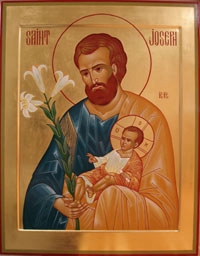Thought of the week
How often I think
I am too busy to pray!
My days are over loaded!
I say Jesus, I love you.
You are here: Home / Associated Text
 Iconography is a sacred art which originated during the Byzantine era. Although it was once important among Catholic Christians a long time ago, it is rather the Orthodox Christians who preserved the tradition.
Iconography is a sacred art which originated during the Byzantine era. Although it was once important among Catholic Christians a long time ago, it is rather the Orthodox Christians who preserved the tradition.
An icon is the visual translation of the Word of God, the Gospel in form and color. It is the mystery of God which is revealed by the eyes for the heart.
The very foundation of iconography is the Incarnation of God. “No one has ever seen God; it is the only Son, who is close to the Father’s heart, who has made him known.” (Jh 1, 18) “Anyone who has seen me has seen the Father.” (Jn. 14, 9) In fact, Jesus is the living icon of the Father. The saints incarnate the presence of God on earth and it is his spiritual traits that must be revealed in an icon. That is why icons of the saints are never, at any time, their portrait. There is an absence of naturalism.
The materials, the colors, the traits, the gestures, the structures are symbolic and adhere to strict rules. Also, an icon is characterized by the absence of shade and the omnipresence of light; gold represents divine light, and the lighter areas of clothing and skin, humanity rising towards divinity.
My personal story with icons began in the 90’s. Certainly by error, I had entered a religious art store. It was a time in my life when, I must admit, everything concerning religion repelled me immensely. To my great astonishment, I was sort of “drawn up” by an icon of Christ Pantocrator. I was overwhelmed! Not familiar with this type of event, I decided to buy the icon. A little, or rather quite ill at ease to buy “that”, I said with a laugh, to the salesclerk “It wants to come home with me that one” to which she answered, “Madam, we do not choose icons, they choose us.” I finally found an inconspicuous spot in the house to expose it. I forgot about it…for a long time. I now realize that this icon initiated in me a fissure, a fissure that has consistently grown to the point of finally reaching my innermost heart. It initiated many changes.
Icons re-emerged in my life in 2005 at the occasion of an exhibition when I literally fell in love with them; I then decided to invest in them. Although laborious, I love the technical aspect of that art and, moreover, the subjects fascinate me. In 2006, after a bit of research on Saint Joseph, I decided to write an icon. The drawing was composed by a master iconographer, Alexandre Sobolev.
What the symbols represent: